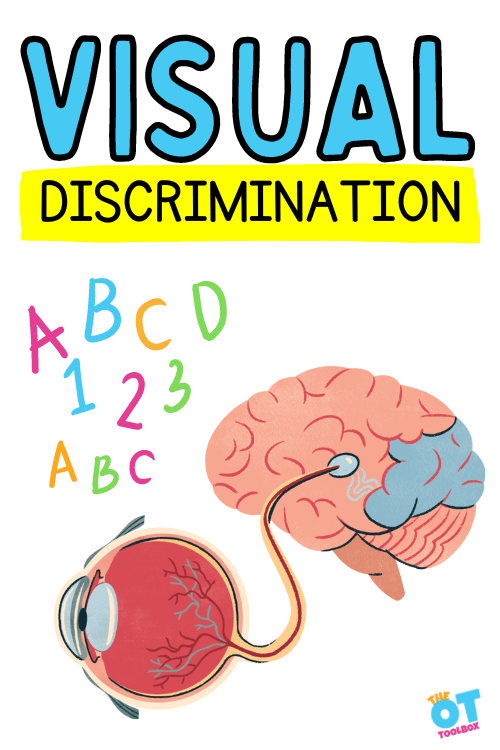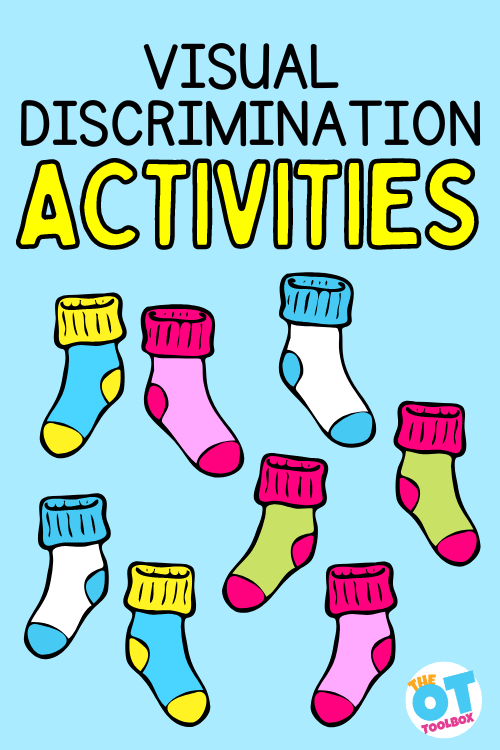
Colleen Beck, OTR/L is a pediatric occupational therapist and the owner and author of The OT Toolbox website. She manages all of The OT Toolbox social media accounts and runs the popular newsletter. Colleen created The OT Toolbox in 2011 and since then has written thousands of blog posts designed to support therapy providers, educators, parents, counselors, admin, and caregivers in promoting the healthy development of kids. Check out Colleen's blog posts below:
Visual discrimination is just one of the seven types of visual perception impacting visual efficiency. While the word “discriminate” has many different meanings, visual discrimination refers to the ability to tell the difference between things. Someone who has “discriminating taste” can tell the difference between Heinz and off brand ketchup, for example. This blog post is part of a series highlighting Visual Perception.

Visual discrimination can be defined as the ability to is determine and classify objects, symbols, shapes, etc. by differences in color, form, size, texture, or orientation, or shape by the eyes receiving visual input and analyzing that information. Visual discrimination occurs by the eyes and brain detecting differences in objects, utilizing working memory and stored memory to determine distinct differences or matched features. This visual skill is necessary for reading, writing, math skills, play, activities of daily living, and essentially all aspects of utilizing visual input. Visual discrimination is a skill that kids need for so many skills. From identifying and matching socks when getting dressed and doing laundry to recognizing subtle differences in multiple choice problems, visual discrimination is a visual perceptual skill that allows kids to excel in reading, writing, and math activities or struggle! When explaining visual discrimination, it is important to understand it’s role in visual perception as part of the overall visual processing system. One aspect of visual processing is the component of visual motor skills. Included in visual motor skills are three main areas: Visual motor skills are made up of several areas: 1. Visual Processing Skills- how the eyes move and collect information. Visual processing skills includes visual tracking, convergence, saccades, visual fixation, and visual attention. A component of visual processing includes visual efficiency. 2. Visual Perceptual Skills- ability to make sense of what we see. Visual perceptual skills are essential for everything from navigating our world to reading, writing, and manipulating items. Visual perception includes visual memory, visual closure, form constancy, visual spatial relations, visual discrimination, visual attention, visual sequential memory, and visual figure ground. 3. Eye-Hand Coordination- Using the visual input effectively and efficiently with the hands allows us to manipulate and manage objects and items. This area enables us to use visual information in a motor action. Eye-hand coordination requires fine motor dexterity, strength, shoulder stability, core stability, etc.
In order to read fluently, the brain clumps letters together to form familiar words. There are tests that show the beginning two letters to a word with the rest jumbled.
The brain is able to use the context clues to read the jumbled texts. The brain is also able to read upside down, backward, and in different fonts. Perception happens beyond the eyes.
The eyes are just the window, or lens. The brain is responsible for perceiving or making sense of what the lens has seen.
Reading fluently requires quickly being able to tell the difference between fonts, discriminating between similar letters (b, d, p, q), clumping words together, determining where one word begins and ends, recognizing familiar words, and other decoding skills.
People with dyslexia are not readily able to perceive the difference between these similar letters or words. They are able to “see” correctly, but their brain often reverses or mixes the letters and words, making it much more labor intensive to decode. The good news is, the brain can be trained to make sense of what it sees.
Once you have determined visual acuity is 20/20, or has been corrected to working vision, watch for these common signs of visual discrimination issues:
Fun Fact!
According to theories, males DO have more difficulty with visual perception than their female counterparts. Males are genetically programmed to hunt, gather, and protect.
They were not hardwired to cook, clean, shop, match items together, etc. Males have not evolved quick enough to meet the ever changing challenges they face on a daily basis!
According to the University of Washington, males can see motion and colors differently than females. This lends to the hunting/protecting theory, however is also linked to autism spectrum disorders in males.
You can give the males in your life some slack when they just “can’t find” the salad dressing in the fridge next time!
When doing visual perceptual testing, it is important to isolate visual perception from motor skills. Having students touch the answers rather than writing them, or calling out letters, is a better measure of visual perception.
The following is a partial list of popular assessments. The VMI subtest is more of a screener than a true visual perception test.

Visual discrimination activities happen everyday through functional tasks. To work on these specific underlying visual processing skills, it is possible to target visual discrimination development through play, games, and activities.
Additionally, there are numerous worksheets, games, activities, and resources available on visual discrimination.
The good news is, visual perceptual skills can be improved through practice and brain training, and can be incorporated into the client or student’s specific interests and goals.
The visual discrimination activities below support development and refinement of the skills needed to process differences in forms or objects.
The most important testing tool you can use is to rule out “visual acuity” problems before visual perception. Vision plays a major role in learning and visual discrimination is just one aspect of vision and learning.
A pair of glasses is a much easier and straight forward fix than years of visual perceptual training.
Visit a qualified ophthalmologist to check for any vision difficulties. Once these are ruled out, use one of the great testing materials listed above to determine any visual perception deficits.

Victoria Wood, OTR/L is a contributor to The OT Toolbox and has been providing Occupational Therapy treatment in pediatrics for more than 25 years. She has practiced in hospital settings (inpatient, outpatient, NICU, PICU), school systems, and outpatient clinics in several states. She has treated hundreds of children with various sensory processing dysfunction in the areas of behavior, gross/fine motor skills, social skills and self-care. Ms. Wood has also been a featured speaker at seminars, webinars, and school staff development training. She is the author of Seeing your Home and Community with Sensory Eyes.